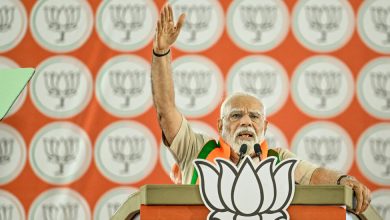How Catholics Avoided Paying Millions in Reparations for Residential Schools

On Friday, after Pope Francis ended a series of meetings with Indigenous people from Canada with an apology for the role the Roman Catholic Church played in a notorious residential school system, my colleague Elisabetta Povoledo got the chance to talk with some members of the Indigenous delegations.

The president of the Métis National Council, Cassidy Caron, second from left, with other Indigenous delegates.Credit…Guglielmo Mangiapane/Reuters
Elisabetta, who is based in Rome but grew up in Winnipeg, spent much of the week following the delegates. She told me on Friday that the mood at their hotel and during a news conference following the final papal audience was “very upbeat.”
“The pope’s words today were historic, to be sure,” said Cassidy Caron, president of the Métis National Council. “They were necessary, and I appreciate them deeply.” She went on, “And I now look forward to the pope’s visit to Canada, where he can offer those sincere words of apology directly to our survivors and their families whose acceptance and healing ultimately matters the most.”
[Read: ‘I Feel Shame’: Pope Apologizes to Indigenous People of Canada]
[Read: Pope Meets With Groups Requesting Apology for Indigenous Schools]
But among the many issues still lingering between the Catholic Church and Indigenous people in Canada are cash reparations. While there were apparently raised during the meetings this week, Elisabetta said that no one she spoke with would offer details of those discussions.
Reparations were due under a landmark settlement in 2006 of a class-action lawsuit brought by former students. Most of the 4.7 billion Canadian dollars that were paid as reparations to Indigenous peoples came from the federal government. Protestant churches paid about 9.2 million Canadian dollars.
But the Catholic Church, which operated about 70 percent of the more than 130 schools, only paid 1.2 million of the 25 million Canadian dollars it agreed to raise in cash contributions as reparations.
In 2013, the federal government challenged the millions of dollars in legal and administrative fees the Catholic Church intended to count as part of its settlement payments at Court of Queen’s Bench for Saskatchewan.
Disagreements over a proposed settlement of that case set off a legal chain reaction. In the course of it, a lawyer for the church told the court that the Catholic fund-raising drive came up with only 3.9 million Canadian dollars for the settlement — about 1.3 million of which was paid to a private fund-raising company. What happened to the remainder is unclear.
The government contended that, in exchange for a payment from the church of 1.2 million Canadian dollars, it agreed to settle the dispute over the church’s claim for fees. The church’s lawyers, however, said that the relatively small payment was to relieve the church of all settlement obligations, including the 25 million Canadian dollars.
Last October, the CBC and The Globe and Mail reported, based on newly released documents, that the judge sided with the church. The decision allowed the church to walk away from its reparations payments.
Then the federal government started an appeal of the court’s decision, only to drop it.
Among the many people shocked last fall by the revelations was Marc Miller, the minister responsible for Indigenous relations, who, like all members of the Liberal government, believes that the church should have been held to its commitment of 25 million Canadian dollars.
“As everyone, I’m dumbfounded by it,” Mr. Miller told The Canadian Press in November, making particular note of his confusion over the government’s decision to end the appeal. “I want to get to the bottom of it,” he said.
On Friday, I asked Mr. Miller what, if anything, his office had discovered. It turns out that the Conservative government of Prime Minister Stephen Harper, in its final months in office, struck a deal with the church that limited the church’s payment to 1.2 million Canadian dollars.
In September 2015, weeks before a federal election, Mr. Harper’s Indigenous affairs minister, Bernard Valcourt, ordered officials to drop the appeal and release the church from its financial obligations in exchange for the payment of 1.2 million Canadian dollars.
Government officials put Mr. Valcourt’s order into place in October 2015, after the Conservatives’ electoral defeat and five days before Justin Trudeau and his cabinet were sworn into office.
“This was a decision of the previous Conservative government,” Justine Leblanc, a spokeswoman for Mr. Miller, wrote in an email. “We cannot speculate as to their internal decision-making process.”
In September the Canadian Conference of Catholic Bishops announced it would make a second fund-raising attempt with a target of collecting 30 million Canadian dollars over five years. Instead of engaging in a national effort, it will rely on each of the church’s 73 dioceses to raise money locally. In late January, the conference set up a charity to collect and manage the money.
On Friday, I asked the conference if any local fund-raising efforts had started and how much money, if any, had been raised. The group did not respond to my inquiry.
Trans Canada
-
In the latest development of the seemingly never-ending series of investigations and charges related to sexual impropriety within Canada’s military, Jonathan Vance, the former top military commander, pleaded guilty to obstruction of justice this week. Mr. Vance was given a discharge saving him from a criminal record in the case, which stemmed from a military police investigation into allegations that he engaged in sexual misconduct during his time as chief of the defense staff.
-
Garth Drabinsky, the Canadian impresario who was convicted of fraud and forgery and sentenced to five years in prison, is back on Broadway.
-
Valérie Lemercier spoke with Elisabeth Vincentelli about the making of “Aline,” her fictionalized telling of Celine Dion’s life.
-
A new Netflix documentary, “Trust No One: The Hunt for the Crypto King,” explores the story of Gerald W. Cotten, the founder of the Canadian cryptocurrency exchange Quadriga CX, who died in 2018 and left many users shut out from accessing their funds.
-
Caden Ricci, a 10-year-old boy in Montreal who has been diagnosed with autism, is using a QTRobot as a friend and teacher, Alina Tugend writes.
-
In real estate, Shivani Vora writes that, among buyers from around the world, Canada “has become popular and well regarded for its golf as well as golf homes.”
A native of Windsor, Ontario, Ian Austen was educated in Toronto, lives in Ottawa and has reported about Canada for The New York Times for the past 16 years. Follow him on Twitter at @ianrausten.
How are we doing?
We’re eager to have your thoughts about this newsletter and events in Canada in general. Please send them to [email protected].
Like this email?
Forward it to your friends, and let them know they can sign up here.




